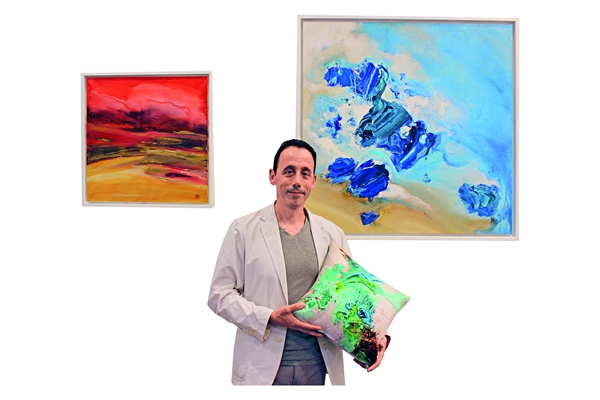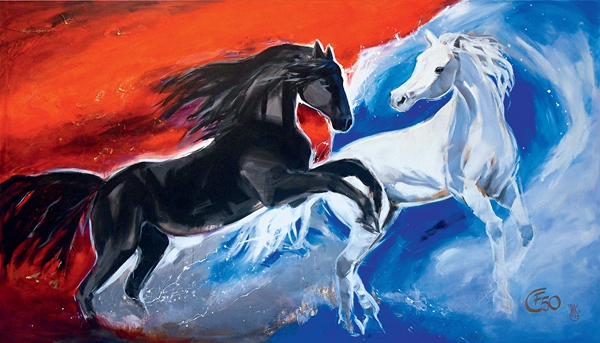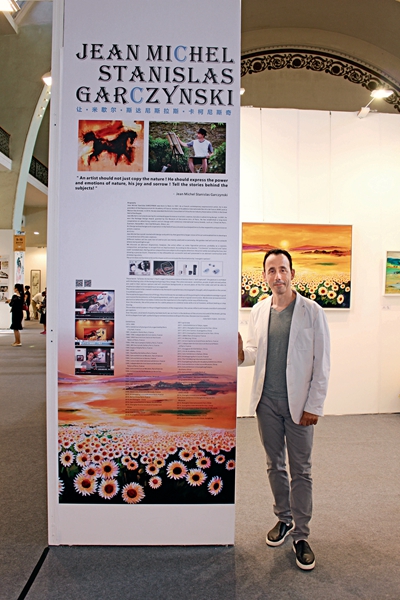Jean Michel’s Artistic Journey in China
China Today, April 26, 2017 Adjust font size:
Half a year ago, I met up with an old friend, Jean Michel Stanislas Garczynski. He had just arrived in Beijing, having traveled 2,300 km from the southern city of Guangzhou, to attend the 19th Beijing International Art Exhibition at the Beijing Exhibition Center.
The contemporary French expressionist artist has lived in China for six years and loves everything about China: “The food, the cities, the people’s lifestyles... Everything here is just perfect for me.” His excellent works and charming personality have won Jean Michel many friends in China, and he is a popular artist – his Chinese fans call him Uncle Mi. This time at the art fair, Uncle Mi brought us new works that were just as impressive as his old ones.
|
|
|
Jean Michel and his abstract works. |
Jean Michel started painting aged 12 and won first prize at the Young Artists Competition of Meudon in Paris aged 16. He graduated top of the class from Ecole Professionnelle de Dessin Industriel (EPDI) at 24, and soon afterwards was invited to attend the Palm Art Salon organized by Paris City Hall as one of the youngest artists. In the same year, he single-handedly completed a giant 25-square-meter mural, which was displayed at the Champs Elysées in Paris.
Born in 1957 in Paris, Jean Michel is now president of the Expressionist Art Academy of France, and a member of many French artistic associations such as Académie Internationale Des Arts de France (AIAF) and La Maison Des Artistes. In China in 2014, he was awarded the title of Artistic Consultant of China Horse Industry Association (CHIA) in Beijing. To add more strings to his bow, he also holds other posts such as designer and creative director of French luxuries.
Destiny Brought Me to China
Jean Michel first came to China in 2008 to attend an art salon in Shanghai. In retrospect, he believes “destiny” brought him to China: “I made a friend who invited me to join an exhibition in China. It was not my plan, but God’s.” However, it was not a smooth experience. In 2008, Beijing hosted the Olympic Games. When the Olympic torch relay came to Paris, several Tibetan separatists tried to sabotage the relay and the then French President Sarkozy met with Dalai Lama, a separatist leader of Tibet. Many Chinese felt offended by the meeting and tension between China and France rose. Localized resistance against all things French ensued. Jean Michel, therefore, entered the Chinese market at a bad time. Although his works drew lots of attention, they did not sell. His Chinese dream was indeed “off to a bad start.”
|
|
|
Jean Michel’s oil painting A Friendship of Half a Century. |
Jean Michel went straight back to France. It was two years later in 2010 when he considered entering the Chinese market again to continue his artistic journey. “Despite the rough ride last time, I liked China a lot and wanted to continue creating there.” This time he went to the southern city of Guangzhou where he stayed for six consecutive years and set up his own studio. When asked why he chose Guangzhou, Jean Michel said he liked the climate and his works were well received there. “My paintings were becoming more and more popular among Chinese people.” So, he spent six months of every year in China, travelling and painting and making friends with the local people.
Chinese Elements in Art
Jean Michel’s works belong to the genre of expressionism, a modernist movement initially prevalent in poetry and painting stemming from Scandinavian countries at the beginning of the 20th century. It presents the world from a subjective perspective and seeks to evoke moods or ideas by distorting physical reality for emotional effect.
“An artist should not just copy nature, he should express the power and emotions of nature, his joy and sorrow, and tell the stories behind the subjects through his paintbrush!” These now famous lines describe how Jean Michel understands contemporary art.
|
|
|
Jean Michel attends the 19th Beijing International Art Exhibition at the Beijing Exhibition Center. |
Before coming to China, Jean Michel’s painting style evolved from abstract to figurative. He mainly painted abstract works but also incorporated abstract elements into some of his figurative paintings. “Abstract art is a great way of expressing our ideas in the contemporary world. I’m especially fond of expressing the universe in this way.” But after he came to China, he found out that the Chinese prefer figurative paintings, so he adapted to the market and painted things derived from real sources such as landscapes. He also noticed that Chinese people prefer paintings with subtle gradations of colors. He made corresponding changes to his own works to show how different colors can blend and how the distance of objects can be depicted. Inspired by the poetic grace of Chinese artworks, he added more Chinese elements to his own creations.
Jean Michel’s work is highly influenced by Chinese culture, too. For example, the magnificence of China’s mountains and its beautiful scenery is a recurring theme. He has painted works depicting the Great Wall, Qingcheng Mountain, Leshan Mountain, and the landscapes of Guilin. What’s more, traditional Chinese philosophical ideas such as fengshui, qi, and the yin/yang dichotomy are also manifest in his works.
Furthermore, he pays special attention to the use of numbers in his works. The number four is always avoided as he knows Chinese people don’t like it. “When I am painting horses, for example, I will paint six or eight horses, not four.” When it comes to choosing the colors of a painting, he would normally choose warm-toned or bright colors, which are preferred by Chinese people. As abstract art gains in popularity among Chinese collectors, Jean Michel has now returned to abstract painting, his most favored style.


